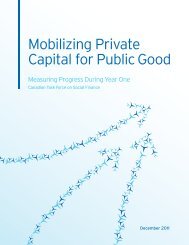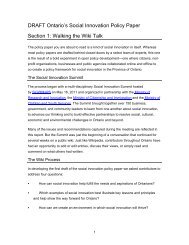Download the report - MaRS Discovery District
Download the report - MaRS Discovery District
Download the report - MaRS Discovery District
You also want an ePaper? Increase the reach of your titles
YUMPU automatically turns print PDFs into web optimized ePapers that Google loves.
<strong>MaRS</strong> White Paper Series<br />
Social Entrepreneurship<br />
Social Venture Finance
2<br />
Enabling Solutions<br />
to Complex Social Problems<br />
Social entrepreneurs recognize social problems and use creative<br />
approaches to design, establish and manage ventures to make social<br />
change and achieve a positive economic return. This series of white<br />
papers explores issues of importance to <strong>the</strong> emergence of a strong social<br />
venture marketplace in Ontario.<br />
Prepared by Kerri Golden, Allyson Hewitt, Michael Lewkowitz,<br />
Michelle McBane & Lisa Torjman<br />
<strong>MaRS</strong> <strong>Discovery</strong> <strong>District</strong>, © 2009
Table of Contents<br />
Introduction / 01<br />
The Emerging Social Finance Marketplace / 02<br />
What Exactly Defines a Social Venture / 02<br />
(a) Social Enterprises (SEs) / 03<br />
(b) Social Purpose Businesses (SPBs) / 04<br />
What Type of Ventures are Emerging in Ontario? / 04<br />
What Type of Funds Invest in Social Ventures? / 05<br />
What are Some of <strong>the</strong> Challenges Faced in <strong>the</strong> Social Finance Marketplace? / 07<br />
Call to Action /11<br />
Selected Bibliography /12
01<br />
Introduction<br />
Social entrepreneurs are mobilizing talent and capital from<br />
both <strong>the</strong> public and private sectors to address complex<br />
societal challenges. However, <strong>the</strong> marketplace for <strong>the</strong>se<br />
ventures is emerging and traditional investment vehicles<br />
struggle to accommodate <strong>the</strong> investment opportunities<br />
presented by <strong>the</strong> social entrepreneurs in <strong>the</strong>ir efforts to<br />
combine a positive economic return with a social impact<br />
mission. As a result, many promising social ventures fail<br />
to achieve <strong>the</strong>ir true potential due to limited access to<br />
resources.<br />
In recent years, <strong>the</strong> need to identify and apply innovative<br />
methodologies to address complex social issues has picked<br />
up momentum among public and private leaders globally.<br />
Some of <strong>the</strong> forces driving <strong>the</strong> need for innovation in this<br />
area include <strong>the</strong> call for action on climate change, poverty<br />
reduction and an aging population with <strong>the</strong> corresponding<br />
pressure on <strong>the</strong> health-care system.<br />
<strong>MaRS</strong> <strong>Discovery</strong> <strong>District</strong>, generously supported by <strong>the</strong><br />
Government of Ontario, recently completed a scan of <strong>the</strong><br />
global social finance landscape - with input from local and<br />
global thought leaders and practitioners - to determine <strong>the</strong><br />
opportunities and challenges supporting <strong>the</strong> growth of social<br />
ventures in Ontario. These innovative enterprises combine a<br />
strong social purpose with sound business principles, ra<strong>the</strong>r<br />
than being solely driven by <strong>the</strong> need to maximize profit.<br />
Supporting <strong>the</strong> development and success of social ventures is<br />
a key component of <strong>the</strong> Government of Ontario’s Innovation<br />
Agenda and Poverty Reduction Strategy.<br />
As a non-profit innovation centre, <strong>MaRS</strong> connects science,<br />
technology and social entrepreneurs with business skills,<br />
networks and capital to stimulate innovation and accelerate<br />
<strong>the</strong> creation and growth of successful Canadian enterprises.<br />
<strong>MaRS</strong> also helps distinct groups such as entrepreneurs,<br />
researchers, investors and policymakers communicate and<br />
collaborate in new ways. By providing a unique platform<br />
and an enabling environment, <strong>MaRS</strong> can help social<br />
ventures become Ontario success stories: financially selfsufficient<br />
organizations that are able to deliver strong and<br />
measurable social impact for <strong>the</strong> communities <strong>the</strong>y serve.<br />
Key Findings<br />
• The social finance marketplace is new and<br />
emerging.<br />
• Social ventures can emerge from both <strong>the</strong><br />
private and <strong>the</strong> non-profit sector.<br />
• The capital for social venture funds can come<br />
from various traditional and non-traditional<br />
sources. Investors will gravitate to <strong>the</strong> type of<br />
investment vehicle defined by <strong>the</strong>ir social and<br />
capital investment return expectations, which<br />
may be market rate, charitable or a mix of <strong>the</strong><br />
two.<br />
• Some of <strong>the</strong> key challenges impeding <strong>the</strong><br />
growth of <strong>the</strong> social marketplace include: <strong>the</strong><br />
limited capital available to social ventures,<br />
<strong>the</strong> lack of familiarity with social finance<br />
among entrepreneurs and capital providers,<br />
social entity structural issues, <strong>the</strong> difficulty in<br />
defining and applying metrics and <strong>the</strong> nascent<br />
nature of <strong>the</strong> marketplace.<br />
• Social entrepreneurs and technology<br />
entrepreneurs face many of <strong>the</strong> same challenges<br />
in scaling a venture. There is an opportunity<br />
to apply best practices from innovators in both<br />
sectors with <strong>the</strong> goal of achieving <strong>the</strong> optimal<br />
scale appropriate for a venture.<br />
This introduction to social venture financing will be <strong>the</strong> first<br />
in a series discussing <strong>the</strong> opportunities and challenges in<br />
<strong>the</strong> social finance ecosystem.
The Emerging Social<br />
Finance Marketplace<br />
Investors and entrepreneurs who take an early risk in<br />
an emerging marketplace will come out <strong>the</strong> winners, as<br />
evidenced by <strong>the</strong> success stories in <strong>the</strong> technology and<br />
life sciences field. A recent presentation by <strong>the</strong> Monitor<br />
Institute detailing <strong>the</strong> four phases of industry evolution<br />
(Figure 1), provides a framework for <strong>the</strong> development of <strong>the</strong><br />
social finance marketplace in Canada.<br />
Globally, <strong>the</strong> United States and <strong>the</strong> United Kingdom<br />
have been leaders in <strong>the</strong> evolution of <strong>the</strong> social venture<br />
marketplace and <strong>the</strong>ir evolution can be categorized at<br />
<strong>the</strong> marketplace-building phase. Based on consultations<br />
completed for <strong>the</strong> study, <strong>the</strong> Ontario marketplace is<br />
more nascent and can be classified as emerging from<br />
<strong>the</strong> uncoordinated innovation stage and entering <strong>the</strong><br />
marketplace building stage as some centres of activity are<br />
beginning to coalesce.<br />
In addition, <strong>the</strong>re are parallels between <strong>the</strong> evolution of <strong>the</strong><br />
technology sector in Canada (which includes information<br />
technology, clean tech and life sciences) and <strong>the</strong><br />
opportunity for knowledge transfer between <strong>the</strong> technology<br />
entrepreneurs and social entrepreneurs.<br />
…The question is whe<strong>the</strong>r <strong>the</strong> bar will be set high enough<br />
– whe<strong>the</strong>r pioneering leaders will provide <strong>the</strong> talent,<br />
discipline and resources that will be needed to create a<br />
coherent marketplace with high standards for impact…<br />
Ka<strong>the</strong>rine Fulton, Monitor Institute<br />
What Exactly Defines a<br />
Social Venture?<br />
Social venture capital is a form of venture capital investing<br />
that provides capital to businesses deemed socially and<br />
environmentally responsible. These investments are<br />
intended to provide attractive returns to investors and to<br />
provide market-based solutions to social and environmental<br />
issues. Ra<strong>the</strong>r than being simply driven by <strong>the</strong> need to<br />
maximize profit, social ventures blend <strong>the</strong> value of social<br />
impact with financial gain.<br />
02<br />
Figure 1 Phases of Industry Evolution 1<br />
IN ONTARIO TODAY<br />
Uncoordinated<br />
Innovation<br />
Marketplace<br />
Building<br />
Capturing <strong>the</strong><br />
Value of <strong>the</strong><br />
Marketplace<br />
Maturity<br />
Disparate entrepreneurial<br />
activities spring up in<br />
response to market need or<br />
policy incentive<br />
Disruptive innovators may<br />
pursue new business<br />
models in seemingly<br />
mature industries<br />
Centers of activity begin to<br />
develop<br />
Infrastructure is built that<br />
reduces transa supports a<br />
higher volume of activity<br />
Growth occurs as<br />
mainstream players enter a<br />
functioning market<br />
Entities are able to leverage<br />
<strong>the</strong> fixed costs of <strong>the</strong>ir<br />
previous investments in<br />
infrastructure across higher<br />
volumes<br />
Activities reach relatively<br />
steady state and growth<br />
rates slow<br />
Some consolidation may<br />
occur<br />
Characterized by lack of<br />
competition except at top<br />
market<br />
Organizations may become<br />
more specialized<br />
1<br />
Ka<strong>the</strong>rine Fulton, Monitor Institute, 2008 http://www.linktv.org/video/3142
03<br />
Figure 2 Social and Financial Return Continuum<br />
Area of Focus<br />
Grant/Donation<br />
Funded<br />
Non-Profit<br />
(Charity)<br />
Revenue<br />
Generating NFP<br />
(Social Enterprise)<br />
Social Venture<br />
(Blended value<br />
proposition)<br />
Social Purpose<br />
Business<br />
(Embedded<br />
multiple bottom<br />
lines)<br />
Traditional<br />
Business<br />
Social (Charitable)<br />
Financial (Commercial)<br />
RETURN<br />
Social ventures have emerged in <strong>the</strong> economy in two ways:<br />
as social enterprises (“SE”) from <strong>the</strong> non-profit sector, and<br />
as social purpose businesses (“SPB”) from <strong>the</strong> for-profit<br />
sector. Figure 2 details how <strong>the</strong>se investment opportunities<br />
fit along <strong>the</strong> social-financial return continuum.<br />
(a) Social Enterprises (SEs)<br />
This model of social venture has emerged from <strong>the</strong> nonprofit<br />
and voluntary sector as organizations seek to become<br />
more self-sufficient and financially sustainable. SEs are<br />
revenue-generating entities that are owned and operated by<br />
a non-profit organization. Since <strong>the</strong>re are no shareholders<br />
in a non-profit organization, <strong>the</strong> profits are fully reinvested<br />
into <strong>the</strong> work of <strong>the</strong> organization.<br />
The emergence of revenue-generating activities has created<br />
a new operating model where business principles, market<br />
characteristics and values (competition, diversification,<br />
entrepreneurship, innovation and a focus on <strong>the</strong> bottom<br />
line) co-exist and work with traditional public sector values<br />
of responsiveness to community and serving <strong>the</strong> public<br />
interest. Non-profits are adopting an enterprising approach<br />
not only to be more financially sustainable but also to<br />
enhance <strong>the</strong>ir missions and increase <strong>the</strong>ir impact.<br />
that <strong>the</strong> SE must have a goal or a mission beyond simply<br />
generating funds for its parent organization and must<br />
demonstrate, through its business model, some behaviour<br />
that will benefit <strong>the</strong> community in which it operates.<br />
The ReStore retail outlets of Habitat for Humanity provide<br />
an excellent example of a Social Enterprise. Quality used<br />
and new surplus building materials are sold for a fraction of<br />
<strong>the</strong> market prices, helping <strong>the</strong> environment by providing a<br />
retail channel to re-use valuable construction materials. The<br />
proceeds from <strong>the</strong> retail outlet fund <strong>the</strong> construction of new<br />
Habitat for Humanity homes within <strong>the</strong> local community.<br />
The typology of an SE is fur<strong>the</strong>r defined by Tessa Hebb 2 , <strong>the</strong><br />
Managing Director of <strong>the</strong> Centre for Community Innovation<br />
at Ottawa’s Carleton University. She defines three<br />
dimensions as critical to <strong>the</strong> classification of an SE:<br />
(i)<br />
(ii)<br />
(iii)<br />
Their degree of financial self-sufficiency;<br />
The degree of social transformation aspired to<br />
and achieved;<br />
The degree of innovation employed in <strong>the</strong> achievement<br />
of <strong>the</strong> mission.<br />
In order to distinguish SEs from traditional fundraising/<br />
revenue-generation activities within a non-profit<br />
organization, <strong>the</strong> BC Centre for Social Enterprise suggests<br />
2<br />
Dr. Tessa Hebb et al, Financing Social Economy Enterprises, Ottawa Carleton Centre for Community Innovation, 2006
(b) Social Purpose Businesses (SPBs)<br />
Social Purpose Businesses are commercial for-profit<br />
entities, created by entrepreneurs to address social issues<br />
that maintain <strong>the</strong>ir social purpose at <strong>the</strong> core of <strong>the</strong>ir<br />
operations, while existing in <strong>the</strong> market economy. Many<br />
successful examples of SPBs can be found internationally<br />
focused on a range of societal challenges, ranging from<br />
environmental impacts through clean tech to poverty<br />
reduction through microfinance initiatives. (See IceStone<br />
case study)<br />
The return continuum in Figure 2 enables <strong>the</strong> distinction<br />
between Social Enterprises, Social Purposes Businesses<br />
and <strong>the</strong> increasing involvement of traditional companies<br />
in adopting social or environmental causes as part of <strong>the</strong>ir<br />
community outreach programs. As important and altruistic<br />
as <strong>the</strong>se Corporate Social Responsibility (“CSR”) initiatives<br />
are, <strong>the</strong>y are typically not embedded into a for-profit<br />
company’s core mission.<br />
What Type of Ventures are<br />
Emerging in Ontario?<br />
Currently, <strong>the</strong> majority of Ontario’s ventures pursuing social<br />
aims fall into <strong>the</strong> non-profit category, as this is where social<br />
problems have historically been addressed. In addition, <strong>the</strong><br />
current legal structure for non-profit entities significantly<br />
limits <strong>the</strong> scaling of business activities within those entities,<br />
preventing access to traditional investment capital.<br />
Case Study<br />
IceStone (www.icestone.biz), a New York-based company,<br />
developed an innovative process for manufacturing highly<br />
durable concrete surfaces made from recycled glass<br />
and cement. Not only does <strong>the</strong> product rival <strong>the</strong> likes of<br />
granite but it also offers builders and o<strong>the</strong>r consumers<br />
an alternative to products that are environmentally<br />
unsustainable. The founders of IceStone are so dedicated<br />
to making a positive impact, that aside from <strong>the</strong>ir<br />
environmental focus <strong>the</strong>y also hire vulnerable populations<br />
for living-wage jobs in <strong>the</strong>ir factories. Take away IceStone’s<br />
social mission — something intrinsic to its purpose — and<br />
<strong>the</strong> company would be a different entity altoge<strong>the</strong>r.<br />
04<br />
We will discuss <strong>the</strong> limitations of <strong>the</strong> legal structure below<br />
as part of an overview of some of <strong>the</strong> hurdles that need<br />
to be overcome in order to continue <strong>the</strong> maturation of <strong>the</strong><br />
Canadian social finance marketplace.
05<br />
What Types of Funds Invest in Social Ventures?<br />
Social venture funds typically invest in enterprises that provide a strong social impact: areas such as health, environment,<br />
education, housing and microfinance summarize <strong>the</strong> typical investment focus area for funds. Social venture funds<br />
generally fall into three categories:<br />
Figure 3 Types of Venture/Community Development Funds<br />
Type of Fund<br />
Regional<br />
Characteristics<br />
• The funds are focused on applying a social venture capital model to regional<br />
development and are often driven by government mandate or by specific<br />
individuals who have a deep desire to support <strong>the</strong>ir region.<br />
• These funds are generally part of a long-term comprehensive strategy to<br />
nurture <strong>the</strong> social venture community in <strong>the</strong> region.<br />
• As this type of fund is typically constrained from a geographical perspective,<br />
<strong>the</strong> fund may use a broad definition for <strong>the</strong> type of social venture that will fit its<br />
investment mandate.<br />
Sector-Specific<br />
• The fund may be supported by tax incentive strategies and will often look to<br />
leverage existing community investment programs.<br />
• These funds, typically seed and early-stage investors, focus on one or more<br />
specific sectors (determined by <strong>the</strong>ir fund size).<br />
• These funds are most like conventional venture capital funds and rely on deep<br />
sector expertise, partner and customer networks in order to uncover and<br />
nurture <strong>the</strong> most successful investments.<br />
• The geographic focus of <strong>the</strong>se funds is fairly large to maximize quality deal flow,<br />
while balancing <strong>the</strong> need to be relatively close in order to provide <strong>the</strong> portfolio<br />
companies with <strong>the</strong> necessary support to successfully scale <strong>the</strong> enterprise.<br />
Opportunistic<br />
• These funds seek <strong>the</strong> best deals from a broad range of sectors and can include<br />
any deal (except for a small set of off-limit areas).<br />
• Investment occurs at <strong>the</strong> growth stage where <strong>the</strong> core team and business<br />
model have been proven (typically >$2 million in revenue and assets).<br />
• Funds have a broad definition of social venture, including cleantech ventures<br />
and those that produce, sell or distribute sustainably produced goods.<br />
• These funds will have broad geographic coverage (national, continental and global).
06<br />
Social venture funds are emergent in <strong>the</strong> social finance<br />
marketplace and, <strong>the</strong>refore, have limited track records. The<br />
financial returns will likely be lower than a more traditional<br />
venture capital vehicle, with <strong>the</strong> returns offset by <strong>the</strong> social<br />
benefits that <strong>the</strong> ventures are generating.<br />
Figure 4 represents <strong>the</strong> minimum balance social venture<br />
funds would aim to achieve between financial returns and<br />
social returns, ideally aiming at <strong>the</strong> “investment nirvana”<br />
signified in <strong>the</strong> top right-hand corner. The opportunity for<br />
a fund essentially lies where “meaning intersects with a<br />
strategic interest”. Managers who have raised some of <strong>the</strong><br />
early venture funds have typically aligned <strong>the</strong>ir funds’ focus<br />
with <strong>the</strong> interests and return expectations of investors who<br />
have provided <strong>the</strong> fund’s capital.<br />
For example, a fund manager raising capital from<br />
traditional institutional investors in private equity, such as<br />
pension funds and strategic investors, would likely target<br />
in <strong>the</strong>ir fund mandate a higher financial return with a<br />
somewhat lower social return. A fund manager targeting<br />
higher social returns would likely seek out foundations,<br />
high net worth individuals, family offices and Corporate<br />
Social Responsibility (“CSR”) allocations within larger<br />
corporate organizations as part of <strong>the</strong> fundraising strategy.<br />
Figure 4 Target Returns for Social Venture Funds 3<br />
Target Financial Return<br />
Solely<br />
Profit-Maximizing<br />
Investing<br />
FINANCIAL FLOOR<br />
FINANCIAL FIRST INVESTORS<br />
Optimize financial returns with<br />
an impact floor<br />
IMPACT FIRST INVESTORS<br />
Optimize social or<br />
environmental impact with a<br />
financial floor<br />
NONE<br />
IMPACT FLOOR<br />
Philanthropy<br />
NONE<br />
Target Social and/or Environmental Return<br />
HIGH<br />
3 Investing for Social and Environmental Impact: A Design for Catalyzing an Emerging Industry, Ka<strong>the</strong>rine Fulton, Monitor Institute, Jan. 2009
07<br />
What are Some of <strong>the</strong> Challenges Faced in <strong>the</strong><br />
Social Finance Marketplace?<br />
There are many challenges facing innovators in this emerging space. Thought leaders provided a comprehensive list<br />
of issues and gaps that need to be addressed in order to move forward in <strong>the</strong> “marketplace building” phase detailed in<br />
Figure 1. Some of <strong>the</strong> issues discussed include:<br />
Figure 5 Challenges Facing <strong>the</strong> Evolution of <strong>the</strong> Social Finance Landscape<br />
Issue<br />
Lack of Capital and<br />
Experienced Investors<br />
• There are limited sources of capital for entrepreneurs to approach. Many of <strong>the</strong><br />
funds are considered to be demonstration vehicles and have a community focus.<br />
• In Ontario, <strong>the</strong>re are some community development funds and a very limited number<br />
of venture capital funds that provide ei<strong>the</strong>r equity capital or loans to social ventures.<br />
Fund Structure<br />
• The current rules for charities in Ontario and Canada are very restrictive to scaling<br />
revenue-generating activities within a charitable entity.<br />
• The United States and <strong>the</strong> United Kingdom have developed “hybrid” corporate<br />
structures that allow not-for-profit (eg. foundations) and for-profit (eg. corporations)<br />
to invest side-by-side in a venture.<br />
• In <strong>the</strong> US, <strong>the</strong> L3C model provides a vehicle that is uniquely suited to accepting<br />
Program Related Investments (PRI’s) from foundations: investments from <strong>the</strong><br />
foundation’s endowment capital that correspond with <strong>the</strong> mission and programs.<br />
• In <strong>the</strong> UK, <strong>the</strong> community interest company (CIC) is a distinctive corporate entity that<br />
describes a company working for <strong>the</strong> benefit of <strong>the</strong> community. It has <strong>the</strong> advantage of<br />
<strong>the</strong> “company” legal form, which is familiar and well understood by <strong>the</strong> business<br />
community and is flexible enough to adapt to most organizational structures.<br />
Developing <strong>the</strong> Skills of<br />
<strong>the</strong> Social Entrepreneur<br />
Early Nature of Marketplace<br />
Lack of Metrics<br />
• Many of <strong>the</strong> opportunities for social ventures come from <strong>the</strong> non-profit sectors<br />
where traditional business skills are not necessarily embedded in education and<br />
experience. Many community-based entrepreneurs have managed smaller<br />
businesses that have not historically achieved significant scale.<br />
• There are a limited number of examples of local social ventures: if we borrow a<br />
<strong>the</strong>sis from <strong>the</strong> early history of <strong>the</strong> venture capital industry, with more capital<br />
available to social ventures delivering reasonable financial returns and solid<br />
evidence of social impact, <strong>the</strong>n more entities will emerge to absorb <strong>the</strong> capital.<br />
• Social impact measurement is costly to do with analytical rigor and needs to be<br />
analyzed on a case-by-case basis.<br />
• There is a tension for funders: <strong>the</strong>y want metrics but are realizing <strong>the</strong>re is a significant<br />
cost to achieve <strong>the</strong> quality metrics <strong>the</strong>y would desire.<br />
• Broad measures of social impact have limited value and can create inappropriate targets.<br />
• Investment-first investors in <strong>the</strong> social capital market require impact measurements<br />
that are simple and easy for <strong>the</strong> average investor to understand, while impact investors<br />
(philanthropic grantors) will require more sophisticated social measurement tools<br />
to quantify <strong>the</strong> impact of <strong>the</strong>ir investment.
08<br />
One of <strong>the</strong> key learnings from <strong>the</strong> consultations is <strong>the</strong><br />
parallel challenge faced by all entrepreneurs, including<br />
those on <strong>the</strong> social venture side. All business leaders<br />
must be able to develop and articulate a compelling<br />
business plan, raise various types of capital, hire and retain<br />
<strong>the</strong> best management team, scale <strong>the</strong>ir business and<br />
provide a successful exit for <strong>the</strong>ir investors. In <strong>the</strong> case of<br />
<strong>the</strong> social venture, <strong>the</strong> exit would be measured using both<br />
financial and social metrics.<br />
Most early-stage technology and social ventures are risky<br />
by definition. Many of <strong>the</strong> best practices developed in <strong>the</strong><br />
more mature technology sectors to reduce or manage<br />
risk can provide solutions to mitigate some of <strong>the</strong> risks<br />
associated with social ventures. Typical strategies include<br />
using partnerships to scale <strong>the</strong>ir businesses, building a<br />
strong advisory network, recruiting management teams<br />
with deep sector experience and successes and developing<br />
and implementing strong intellectual property (IP)<br />
strategies. The resulting success stories will accelerate<br />
understanding and learning in <strong>the</strong> sector and as a result<br />
should lead to fur<strong>the</strong>r ventures and funds. The story<br />
of Ethiopian coffee, discussed below, is a simple and<br />
elegant example of <strong>the</strong> application of a strategy from <strong>the</strong><br />
technology toolkit (in this case an IP strategy) to help<br />
address a complex social issue. (See Ethiopian coffee<br />
farmer case study)<br />
The consultations also revealed one success factor that is<br />
unique to social ventures and critical to <strong>the</strong> achievement<br />
of <strong>the</strong>ir social impact benefits: Partnerships with <strong>the</strong><br />
social agencies already at work in <strong>the</strong> community where<br />
<strong>the</strong> social venture operates can help deepen <strong>the</strong> impact<br />
and streng<strong>the</strong>n <strong>the</strong> performance of both <strong>the</strong> venture and<br />
<strong>the</strong> larger community agencies supporting <strong>the</strong> social<br />
mission. (See Social Capital Partners case study)
09<br />
Case Studies<br />
Working with <strong>the</strong> community to maximize social impact.<br />
Social Capital Partners is a Toronto-based not-for-profit<br />
organization that believes market forces can be more<br />
effectively utilized to solve structural social challenges<br />
in Canada. In support of this belief, SCP provides growth<br />
financing and advisory services to successful businesses that<br />
integrate a social mission into <strong>the</strong>ir employment strategy by<br />
expanding career opportunities for disadvantaged populations.<br />
One of <strong>the</strong> programs provided by Social Capital Partners<br />
involves partnering with franchisors, like Active Green + Ross,<br />
whereby Social Capital Partners will lend individuals <strong>the</strong> funds<br />
to acquire a franchise at attractive loan rates and, in return,<br />
<strong>the</strong> franchise owner agrees to establish a social hiring and<br />
retention program as a core part of <strong>the</strong>ir HR model.<br />
In order to ensure success for <strong>the</strong> franchise’s operation as well<br />
as <strong>the</strong> individual being hired, Social Capital Partners works<br />
closely with community service agencies such as <strong>the</strong> YMCA<br />
to make <strong>the</strong> recruiting process effective for <strong>the</strong> franchise<br />
owner and to provide high quality after-employment support<br />
programs to ensure <strong>the</strong> individual is successful on <strong>the</strong> job. This<br />
work has resulted in changing <strong>the</strong> way Active Green + Ross<br />
locations recruit new staff – both corporate dealers and <strong>the</strong><br />
franchisees SCP has loans with. Community service agencies<br />
can also leverage <strong>the</strong>ir work with and references from <strong>the</strong><br />
franchise owners to better serve <strong>the</strong>ir community and expand<br />
<strong>the</strong> number of businesses willing to use <strong>the</strong>ir programs and<br />
services to source ‘job ready’ candidates for <strong>the</strong>ir business.<br />
The result is a win/win for <strong>the</strong> social venture, <strong>the</strong> social<br />
agencies and also for <strong>the</strong> members of <strong>the</strong> social community<br />
<strong>the</strong>y both serve.<br />
To read more, see www.socialcapitalpartners.ca<br />
How an IP strategy changed <strong>the</strong> game for<br />
Ethiopian coffee farmers<br />
Ethiopia is <strong>the</strong> birthplace of coffee and is widely recognized<br />
as producing some of <strong>the</strong> finest coffees in <strong>the</strong> world. Coffee<br />
makes up approximately half of all Ethiopian exports and<br />
directly supports <strong>the</strong> livelihoods of millions. Many of <strong>the</strong><br />
large coffee chains were able to charge premium pricing for<br />
<strong>the</strong> finest beans produced by Ethiopian farmers. However,<br />
due to a global over-supply of commodity coffee over <strong>the</strong><br />
last decade, <strong>the</strong> price for all Ethiopian coffee beans was<br />
pegged at <strong>the</strong> low commodity market price.<br />
its coffee and establishes <strong>the</strong> conditions for sale. These<br />
licenses, issued free of charge to coffee companies, have<br />
allowed Ethiopia to charge premium market prices for<br />
<strong>the</strong>ir coffees and major buyers, such as Starbucks, are now<br />
licensees and vigorous supporters. The IP (premium coffee)<br />
and <strong>the</strong> IP tools (trademark, brand, license) used by <strong>the</strong><br />
Ethiopian government has resulted in <strong>the</strong> doubling of <strong>the</strong><br />
price for fine Ethiopian coffees and has already led to visible<br />
economic improvement in Ethiopia.<br />
To read more, see www.ethiopiancoffeenetwork.com and<br />
www.lightyearsip.net<br />
In 2004, <strong>the</strong> Ethiopian Intellectual Property Office Director<br />
took a bold step and implemented an IP strategy based on<br />
<strong>the</strong> belief that IP rights protection played a significant role<br />
in <strong>the</strong> economic boom experienced in developed countries.<br />
The government registered trademarks for three of <strong>the</strong>ir<br />
finest coffees – Harrar, Yirgacheffe, and Sidamo – in 29<br />
countries. Ethiopia selects <strong>the</strong> global distributors for
Call to Action<br />
10<br />
Doing “social good” is an emerging and embedded decision<br />
criterion in how consumers and corporate entities buy<br />
and supply goods and services. Once this marketplace<br />
matures fur<strong>the</strong>r, <strong>the</strong>re will be additional success stories and<br />
mainstream investors will be attracted to <strong>the</strong> investment<br />
opportunity in <strong>the</strong> same way <strong>the</strong>y were when innovations in<br />
technology ventures were first successful.<br />
Jed Emerson 4 , a one-time social worker who is now<br />
<strong>the</strong> Managing Director at Uhuru Capital and founder of<br />
blendedvalue.org, suggests we embrace <strong>the</strong> concept of<br />
blended value, which he defines as follows: value is what<br />
gets created when investors invest and organizations act<br />
to pursue <strong>the</strong>ir mission. Traditionally, we have thought<br />
of value as being ei<strong>the</strong>r economic (and created by forprofit<br />
companies) or social (created by non-profit or<br />
non-governmental organizations). What <strong>the</strong> Blended Value<br />
Proposition states is that all organizations, whe<strong>the</strong>r for<br />
profit or not, create value that consists of economic, social<br />
and environmental value components—and that investors<br />
(whe<strong>the</strong>r market-rate, charitable or some mix of <strong>the</strong> two)<br />
simultaneously generate all three forms of value through<br />
providing capital to organizations. The outcome of all this<br />
activity is value creation, which is itself non-divisible and,<br />
<strong>the</strong>refore, a blend of <strong>the</strong>se three elements.<br />
a unique platform to converge both social and technology<br />
entrepreneurs, <strong>the</strong>reby unleashing <strong>the</strong> potential to develop<br />
innovative solutions to complex social problems. This work<br />
is already underway through SiG@<strong>MaRS</strong>, providing support<br />
and mentoring to social entrepreneurs and <strong>the</strong>ir teams.<br />
In conclusion, social venture capital is a strongly emerging<br />
force in global markets. Although still nascent in Canada,<br />
investment support for Social Enterprises and Social<br />
Purpose Businesses holds tremendous promise to catalyze<br />
a new generation of social change agents. The Government<br />
of Ontario, working with <strong>MaRS</strong>, has <strong>the</strong> opportunity to<br />
assume a leadership role in this field.<br />
A first step in <strong>the</strong> development of success stories for this<br />
social finance marketplace is to a raise a pilot fund that<br />
will take <strong>the</strong> early investment risk and demonstrate <strong>the</strong><br />
efficacy of <strong>the</strong> social venture model to social innovation.<br />
The <strong>MaRS</strong> leadership team is preparing to launch a social<br />
venture capital pilot fund, which would provide a platform<br />
to catalyze fur<strong>the</strong>r investment in <strong>the</strong> social finance area in<br />
Ontario and Canada.<br />
To ensure success, social entrepreneurs must have access<br />
to education, mentoring and support. Talent is now<br />
migrating between <strong>the</strong> non-profit and for-profit sectors and<br />
coordination and collaboration between <strong>the</strong> two will grow<br />
and be critical, along with engagement of public sector<br />
resources that are <strong>the</strong> foundation of financial support for<br />
many organizations in <strong>the</strong> non-profit sector. Many of <strong>the</strong><br />
lessons about investing in and delivering scale from <strong>the</strong><br />
technology sector can be applied successfully to <strong>the</strong> nonprofit<br />
sector and likewise private companies will benefit<br />
from <strong>the</strong> knowledge and experience of <strong>the</strong> non-profit sector<br />
at identifying and solving social problems. <strong>MaRS</strong> provides<br />
4 www.blendedvalue.org
11<br />
Selected Bibliography<br />
In addition to <strong>the</strong> referenced materials, <strong>the</strong> following resources might also be of interest:<br />
• Americans for Community Development, The L3C: The new Way to Organize Socially Responsible and Mission Driven Organizations,<br />
Washington, DC: The Mary Elizabeth & Gordon B. Mannweiler Foundation Inc., 2005-2007<br />
• Stephanie Lessans Geller and Lester M. Salamon with <strong>the</strong> assistance of Nancy Hall, Report on <strong>the</strong> Nonprofit Investment Capital Roundtable -<br />
Communique No. 7, Baltimore, MD: Johns Hopkins University, 2007<br />
• Anna Bubel, Ano<strong>the</strong>r Way, Social Enterprise Fund - Business Case, Edmonton: Edmonton Community Foundation, 2007<br />
• Dr. Tessa Hebb, Arlene Wortsman, Dr. Margie Mendell, Nancy Neamtan, Ralph Rouzier with <strong>the</strong> assistance of Russel LaPointe, Financing<br />
Social Economy Enterprises, Ottawa Carleton Centre for Community Innovation, 2006<br />
• The F.B. Heron Foundation, New Frontiers in Mission Related Investing, New York: The F. B. Heron Foundation, 2004<br />
• Coro Strandberg, Brenda Plant, Scan of <strong>the</strong> Community Investment Sector in Canada, Ottawa: The National Round Table on <strong>the</strong> Environment<br />
and <strong>the</strong> Economy - Capital Markets and Sustaianbility Program, 2004<br />
• nef - National Economics Foundation, Developing a Social Equity Capital Market 2006, Kent, UK: CAF - Charities Aid Foundation, 2006<br />
• Becky Reuber, Rod Lohin, Jason Anatao, Erez Eizenman, Analysis of Social Venture Funds - Overview of <strong>the</strong> Current Landscape, Toronto:<br />
University of Toronto - Rotman School of Management, 2008<br />
• Erez Eizenman, Sarah Stern, Social Venture Capital Funds - New Investment Approaches to Improve Social Conditions, Toronto: University of<br />
Toronto - Rotman School of Management, 2008<br />
• Mark Goldenberg, Building Blocks for Strong Communities - Key Findings and Recommendations, Ontario, Canada: Imagine Canada and<br />
Canadian Policy Research Networks, 2006<br />
• Mark Ventry, The 2007 Ontario Co-operatives & Credit Union Census, Guelph: On Co-op - Ontario Co-operative Association, 2008<br />
• Ka<strong>the</strong>rine Scott, Spyridoula Tsoukalas, Paul Roberts, David Lasby, The Nonprofit and Voluntary Sector in Ontario, Regional Highlights of The<br />
National Survey of Nonprofit and Voluntary Organizations, Toronto: Imagine Canada, 2006<br />
• Malika Hamdad, Sophie Joyal, Satellite Account of Nonprofit Institutions and Volunteering, Ottawa: Statistics Canada, 2007<br />
• Ka<strong>the</strong>rine Scott, Funding Matters: The Impact of Canada’s New Funding Regime on Nonprofit and Voluntary Organizations, Ottawa: <strong>the</strong><br />
Canadian Council on Social Development, 2003<br />
• Jed Emerson, Tim Freundlich and Jim Fruchterman with Loren Berlin and Keely Stevenson, Nothing Ventured, Nothing Gained: Addressing<br />
<strong>the</strong> Critical Gaps in Risk-Taking Capital for Social Enterprise, Oxford: Skoll Centre for Social Entrepreneurship, 2007<br />
• Sara Olsen, Social Ventures: Defining Value, San Francisco: Social Venture Technology Group, 2005<br />
• Mark Kramer, Sarah Cooch, Investing for Impact: Managing and Measuring Proactive Social Investments, Boston: Foundation Strategy Group,<br />
2006<br />
• Jed Emerson, Joshua Spitzer, From Fragmentation to Function: Critical Concepts and Writings on Social Capital Markets’ Structure,<br />
Operation and Innovation, Oxford: Skoll Centre for Social Entrepreneurship, 2007<br />
• Brandy Curtis, New England Community Developments: An Overview of <strong>the</strong> CDFI Industry, Boston: Federal Reserve Bank of Boston, 2006<br />
• Sherri Torjman, Bill Young, Money and Meaning: Blended Value in Community Enterprise, Ottawa: The Caledon Institute of Social Policy,<br />
2007<br />
• Alex Chernoff, Creating Capital Pools to Support Social Enterprise Development in Manitoba, Winnipeg: Social Sciences and Humanities<br />
Research Council of Canada, <strong>the</strong> Canadian Centre for Policy Alternatives, Winnipeg Partnership Agreement, Assiniboine Credit Union, 2008<br />
• Monitor Institute, Investing for Social & Environmental Impact, A Design for Catalyzing an Emerging Industry, 2008<br />
• www.socialfinance.ca, an online platform for <strong>the</strong> community of people and organizations that are actively trying to advance <strong>the</strong> development<br />
of a social finance marketspace in Canada.<br />
• Causeway Policy Brief, Social Finance: Enabling social enterprise for public benefit, Toronto, 2008<br />
• Andrea Baldwin, Creativity, Social Benefit and Job Creation: The Potential for Social Entrepreneurship in Ontario, Toronto: Martin Prosperity<br />
Institute, 2009<br />
• Steven Godeke with Doug Bauer, Philanthropy’s New Passing Gear: Mission-Related Investing - A Policy and Implementation Guide for<br />
Foundation Trustees, New York: Rockefeller Philanthropy Advisors, 2008















